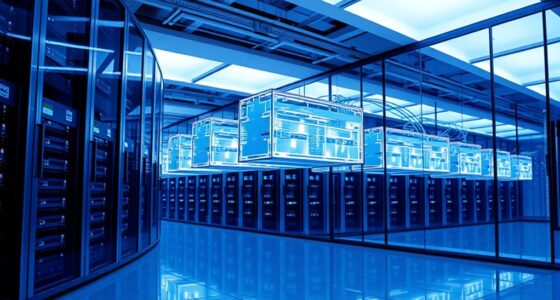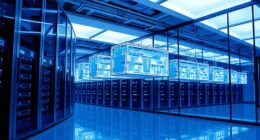Sustainable practices are transforming cloud hosting by markedly reducing environmental impacts through renewable energy adoption and innovative cooling technologies. Major providers aim for 100% renewable power, while efficient server placement and green certifications help lower emissions. Cloud migration itself can cut global carbon footprints by up to 20%. If you want to learn how these advancements are shaping a greener future for cloud infrastructure, there’s more to discover.
Key Takeaways
- Cloud migration reduces global emissions by up to 20%, with major providers aiming for 100% renewable energy by 2025.
- Adoption of renewable energy sources like solar, wind, and nuclear powers greener data centers and ensures reliable, clean energy supply.
- Advanced cooling technologies and energy-efficient hardware significantly decrease data center energy consumption and environmental impact.
- Certifications such as ISO 50001 and Energy Star promote transparency and validate sustainability efforts in cloud hosting.
- Industry leaders target net-zero emissions by 2030, integrating renewable energy and innovative technologies to advance sustainable cloud infrastructure.
The Role of Cloud Computing in Reducing Global Emissions
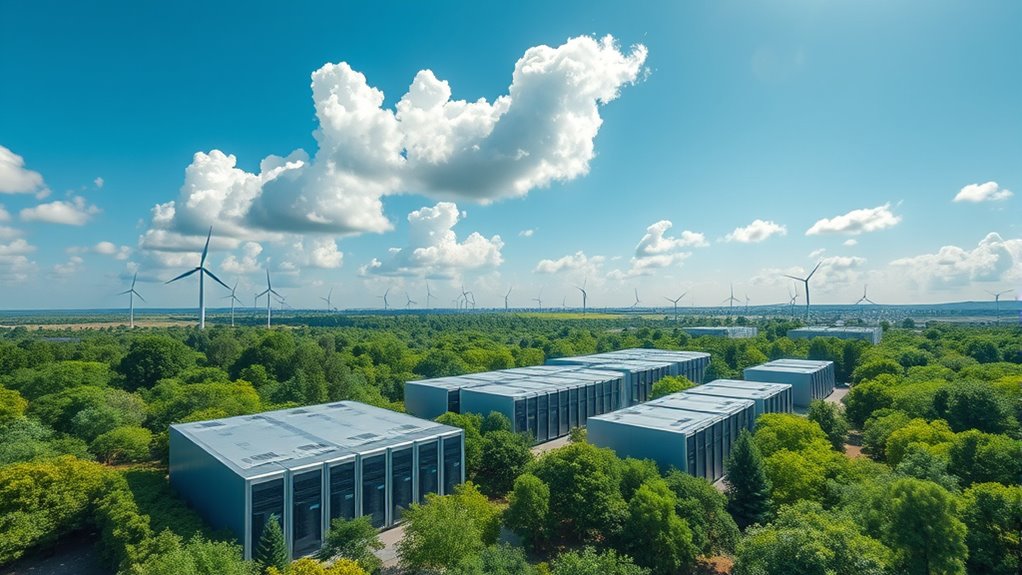
Cloud computing plays a crucial role in reducing global emissions by enabling organizations to optimize their IT infrastructure and cut energy consumption. Moving workloads to the cloud can lower emissions by up to 20%, and adopting Infrastructure-as-a-Service (IaaS) can reduce carbon emissions by as much as 84%. Cloud providers achieve higher server utilization rates, leading to better energy efficiency and fewer emissions per task. Efficient server utilization ensures that data centers operate at maximum capacity with minimal waste. Furthermore, implementing dynamic resource allocation allows cloud systems to adapt to changing demands, minimizing idle resources. Large-scale cloud data centers consume about 2% of global electricity—comparable to entire countries like France—and their energy use is projected to double again by 2026. The integration of renewable energy sources into data centers further enhances their sustainability profile. Additionally, advancements in energy-efficient hardware contribute to reducing the overall carbon footprint of cloud infrastructure. Cloud elasticity helps minimize wasteful energy use by dynamically allocating resources. As a result, migrating to cloud environments considerably decreases energy consumption and carbon footprints, making cloud computing a key driver in global emission reduction efforts.
Renewable Energy Integration in Data Centers
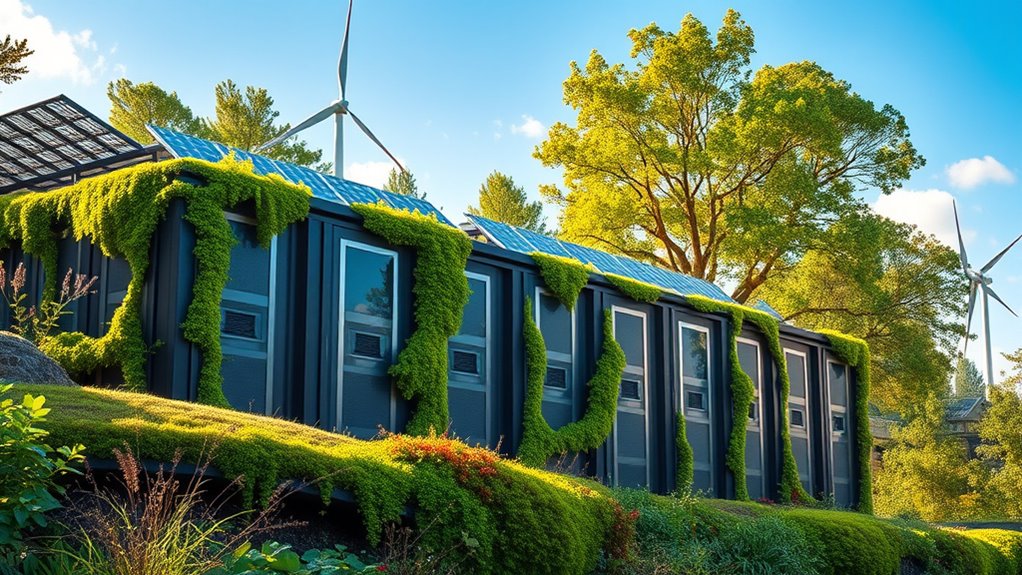
You can substantially reduce your data center’s carbon footprint by integrating solar and wind power, which are becoming more cost-effective and reliable. These renewable sources offer environmental benefits and help meet growing energy demands sustainably. Combining renewable energy with innovative cooling solutions further enhances efficiency and supports green hosting goals. Additionally, adopting energy storage systems like batteries can optimize the use of renewable energy and ensure a steady power supply during periods of low generation energy storage. Incorporating renewable energy sources into operational strategies can improve team dynamics and promote a more sustainable work environment. Moreover, utilizing green energy can significantly lower operating costs over time while reducing carbon emissions.
Solar and Wind Power
Have you ever wondered how data centers are shifting toward cleaner energy sources? Solar and wind power play a vital role in this changeover. Solar-powered data centers are now cheaper than diesel counterparts after initial investments, with costs dropping markedly over ten years. On-site solar can overproduce during peak sun hours, and companies like Apple sell excess energy back to the grid, boosting savings. Payback periods average around 7.2 years and are decreasing as technology costs fall. Wind power is also gaining ground, especially at night when it’s strongest, helping balance energy supply and demand. Major markets like the U.S. and China are projected to see wind energy grow dramatically by 2035. Together, solar and wind are shaping a more sustainable, resilient energy future for data centers.
Renewable Energy Benefits
Renewable energy integration is steadily transforming the way data centers power their operations. By shifting toward cleaner sources like nuclear, hydro, geothermal, and biomass, you reduce reliance on fossil fuels and lower carbon emissions. This transition offers stability, as nuclear provides 24/7 baseload power, complementing intermittent renewables. Many states incentivize renewable use, pushing data centers to adopt greener energy. Tech firms are entering power purchase agreements with nuclear projects to secure reliable, clean power. As AI and cloud demands grow, increasing renewable procurement becomes essential to meet rising electricity needs sustainably. Here’s a quick overview:
| Energy Source | Contribution in 2024 | Future Outlook |
|---|---|---|
| Nuclear | 20% | Growing support |
| Renewables | 24% | Rising adoption |
| Coal | 15% | Declining |
| Natural Gas | >40% | Decreasing share |
Sustainable Cooling Solutions
Implementing sustainable cooling solutions is essential for making data centers more energy-efficient and environmentally friendly. You can leverage advanced technologies like plate heat exchangers to reduce mechanical cooling needs and adopt free cooling methods that use external temperatures to cut energy use. Hybrid systems combine air and liquid cooling, optimizing efficiency across different environments, while immersion cooling offers high density and efficiency through direct contact with eco-friendly fluids. Modular designs facilitate maintenance and upgrades, ensuring your data center stays adaptable. Incorporating variable-speed fans, high-efficiency chillers, and economizing chillers further enhances energy savings. Additionally, zero-water cooling and green refrigerants minimize environmental impact. Proper airflow management is also crucial in optimizing cooling performance and reducing energy consumption. These innovations not only lower energy consumption but also support your sustainability goals, making your data center more resilient and eco-conscious. Moreover, integrating renewable energy sources can significantly decrease your carbon footprint and align your operations with global sustainability efforts. For optimal performance, understanding the energy efficiency of each cooling method can guide more sustainable choices. Incorporating energy-saving strategies can further enhance overall system performance and reduce operational costs.
Innovations in Cooling and Energy Efficiency

How are data centers pushing the boundaries of cooling and energy efficiency to meet growing demands? They’re adopting innovative solutions that maximize heat management and minimize energy use.
- Imagine liquid cooling systems—like direct-to-chip and immersion cooling—replacing outdated air cooling, especially in dense AI workloads, with advanced fluids and scalable chillers up to 20 megawatts.
- Visualize waste heat being captured and redirected to heat entire buildings or industrial processes, transforming a byproduct into a valuable resource.
- Envision AI-driven sensors and analytics constantly monitoring thermal performance, adjusting cooling dynamically, and predicting failures before they happen, ensuring peak efficiency and reducing waste.
These innovations are revolutionizing how data centers operate, making them more sustainable and energy-efficient while handling increased computing demands.
Green Hosting Practices and Certifications
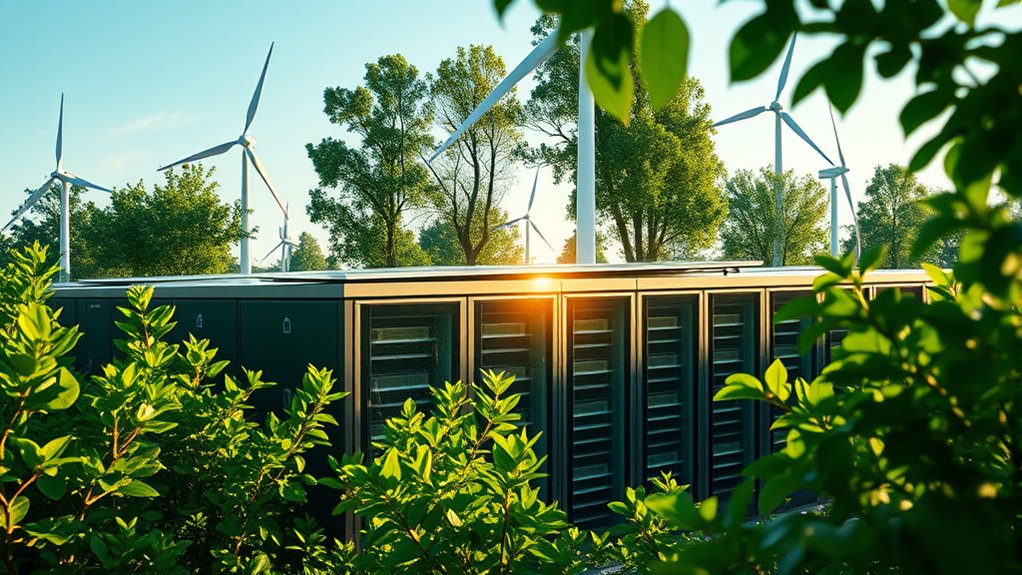
As data centers adopt advanced cooling and energy-efficient technologies, they also prioritize sustainable hosting practices to reduce environmental impact. You can look for facilities implementing ISO 50001 standards for energy management, which boost efficiency and cut energy use. Sustainable design choices, such as using eco-friendly materials, further minimize environmental harm. Many data centers integrate renewable energy sources like solar and wind, decreasing reliance on fossil fuels. Water conservation technologies help reduce water consumption, while effective waste management strategies limit e-waste. Certifications like ISO 50001, Energy Star, and the Green Electronics Council’s EPEAT validate a data center’s sustainability efforts. Additionally, the adoption of energy-efficient cooling systems plays a crucial role in reducing overall energy consumption. Incorporating renewable energy sources not only supports environmental goals but can also lead to long-term cost savings for data centers. Moreover, implementing sustainable design practices can enhance a data center’s environmental performance and appeal to eco-conscious clients. As a result, choosing providers with these certifications can contribute to a more sustainable industry, aligning your hosting needs with environmental responsibility and sustainability.
Impact of Cloud Migration on Carbon Footprints
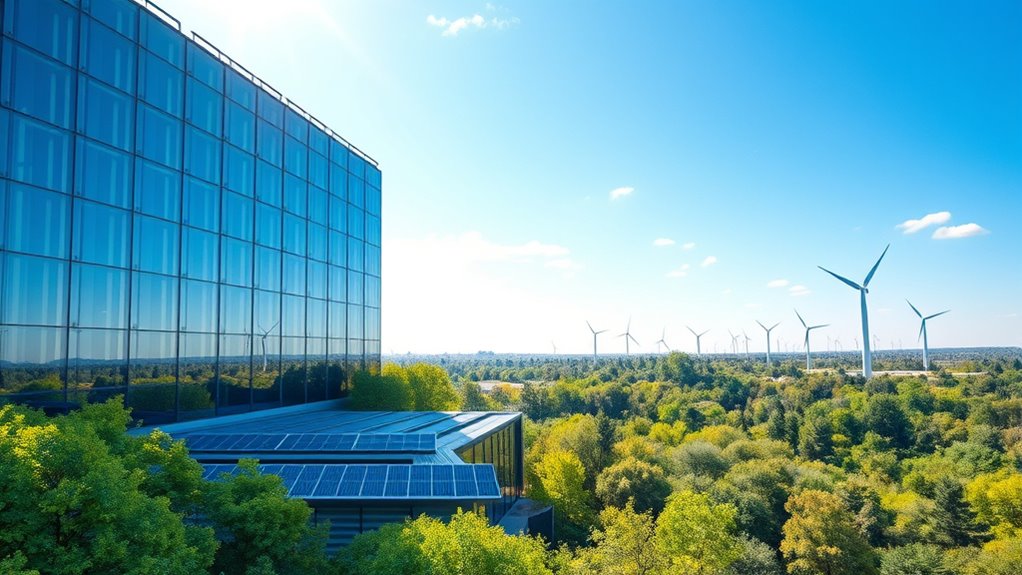
When you migrate to the cloud, you can substantially cut your energy consumption thanks to more efficient data centers. Moving workloads to providers that source renewable energy further lowers your carbon emissions. Incorporating sustainable practices into your cloud strategy can enhance these benefits even further. Additionally, choosing providers that prioritize green energy initiatives ensures a more significant environmental impact reduction overall. Emphasizing energy-efficient hardware in data centers can also contribute to reducing the overall carbon footprint of cloud services. Implementing certified eco-friendly infrastructure can further amplify these positive environmental effects.
Reduced Energy Consumption
Did you know that migrating to the cloud can substantially cut your organization’s energy consumption and carbon footprint? By shifting to cloud services, you can lower your energy use and emissions markedly. Imagine:
- Your IT emissions dropping by 5.9%, equivalent to removing 22 million cars from the road.
- Cloud infrastructure being 3.6 times more energy-efficient than traditional data centers.
- Optimized workloads reducing carbon emissions by up to 99%.
These improvements stem from cloud providers’ focus on energy-efficient hardware, virtualization, and serverless architectures. As a result, your organization can enjoy up to a 30% reduction in energy costs and contribute to a greener future. Incorporating advanced heat pump technology can further enhance energy efficiency in data centers and facilities. Cloud migration isn’t just about scalability—it’s a powerful step toward energy conservation and sustainability.
Shift to Renewable Power
Have you considered how shifting to renewable energy sources impacts your organization’s carbon footprint? Major cloud providers like AWS aim for 100% renewable energy by 2025, and 72% of data centers already use renewables. By 2030, renewables are expected to meet about half of new data center electricity demand, substantially reducing reliance on fossil fuels. This transition enables cloud migration to cut carbon emissions by up to 84%, with some estimates suggesting reductions of up to 80%. Providers like Google target net zero emissions by 2030, and many companies track their emissions using carbon accounting APIs. As more organizations move to green cloud regions and adopt renewable energy, your organization can benefit from lower carbon footprints, helping you meet sustainability goals while contributing to broader industry efforts to reduce environmental impact. Additionally, choosing data centers with cost-effective energy solutions can further optimize your sustainability strategy.
Lower Emissions Levels
Migrating to the cloud can substantially lower your organization’s carbon emissions, with potential reductions of up to 20% globally. By shifting, you contribute to a significant decrease in IT-related emissions—around 5.9%—equivalent to removing approximately 22 million cars from the road. Imagine:
- Cutting CO2 emissions by nearly 60 million tons each year.
- Achieving up to 99% reduction in carbon output for some workloads on platforms like AWS.
- Making data centers five times more energy-efficient than traditional U.S. enterprise facilities.
- Developing a culturally intelligent approach to sustainability initiatives by engaging diverse stakeholders and understanding global environmental perspectives.
- Additionally, utilizing cloud services enhances AI security, ensuring your data remains protected as you pursue sustainability goals. Implementing efficient equipment maintenance practices can further optimize energy consumption and reduce waste.
- Leveraging continuous learning models within AI security systems can help adapt to new environmental challenges and improve overall sustainability efforts.
These improvements not only help the environment but also lower your operational costs through increased energy efficiency. Embracing cloud migration aligns your organization with global sustainability goals while reducing your carbon footprint effectively.
Industry Growth and Sustainability Trends
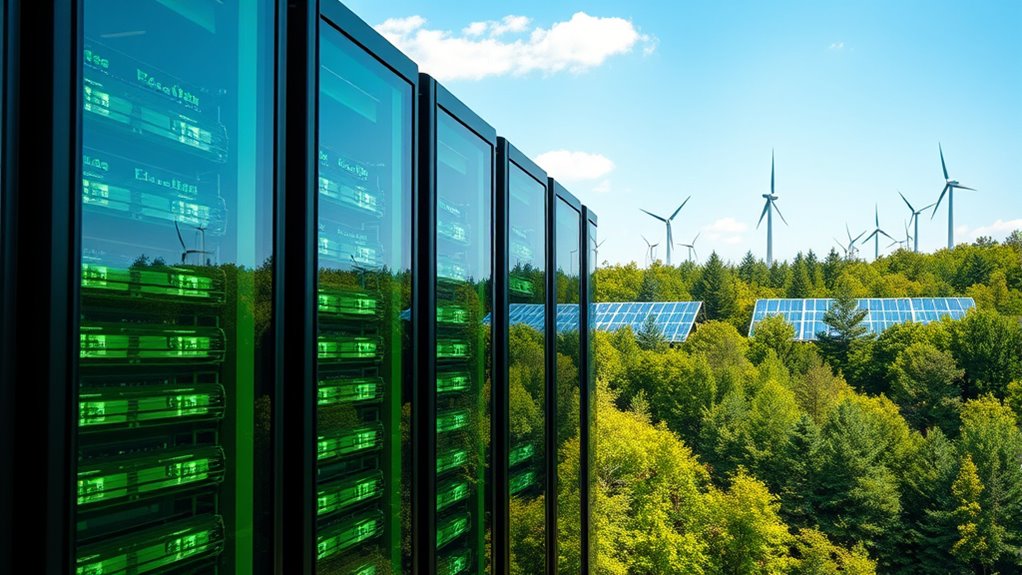
The industry is experiencing rapid growth driven by increasing digital infrastructure, AI, big data, and IoT, with the global cloud computing market expected to exceed $1.6 trillion by 2030. North America leads with about $248 billion in revenue in 2024, while Asia-Pacific, especially China, is expanding quickly, aiming for $121 billion in public cloud revenue by 2027. Cloud providers like AWS, Microsoft Azure, Google, and Amazon are committing to 100% renewable energy and net-zero emissions by 2040 or 2030, boosting sustainability efforts. This growth drives energy efficiency improvements, cutting emissions by up to 84%, and reduces costs by 30-40%. Sectors such as IT, telecom, BFSI, healthcare, and government are adopting green cloud solutions, reflecting a global shift towards sustainable digital infrastructure. Additionally, sound design techniques are increasingly incorporated into multimedia content to enhance user engagement and storytelling.
Strategic Server Placement for Environmental Benefits
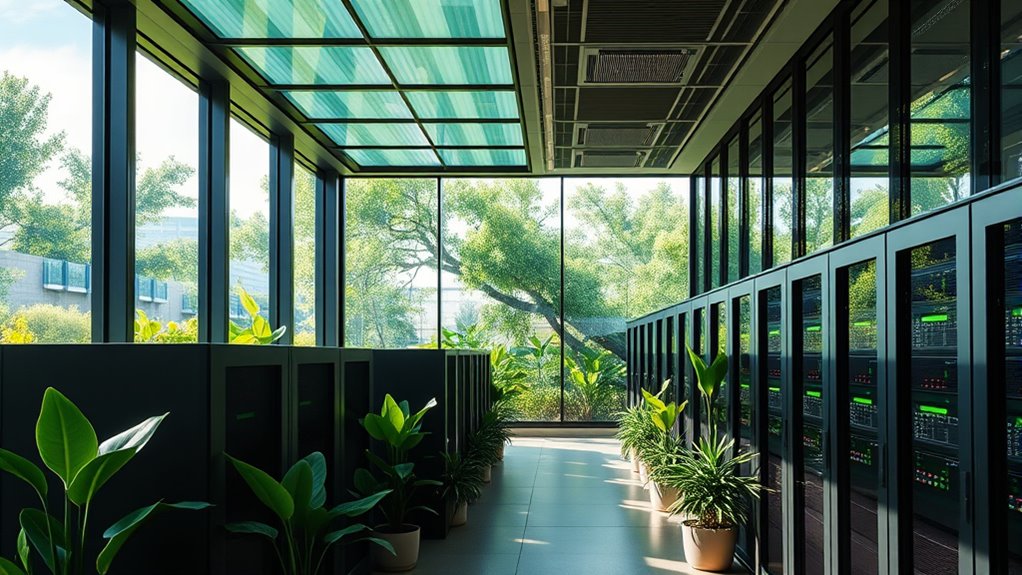
Strategic placement of servers plays a pivotal role in maximizing environmental benefits while supporting the growth of green cloud hosting. By choosing locations near renewable energy sources like solar, wind, or hydro, you cut reliance on fossil fuels and lower carbon emissions. Imagine servers nestled in cooler climates, where natural temperatures reduce cooling energy needs. Visualize sites beside rivers or lakes, enabling sustainable water cooling systems that minimize water use. Also, consider areas with access to low-carbon grid electricity, decreasing your overall footprint. Think of regions with strong renewable incentives and supportive policies, making sustainable operations easier. 1. Positioning near renewable energy hubs to harness clean power. 2. Locating in cool climates to lessen cooling demands. 3. Selecting water-abundant sites for efficient cooling systems.
Technological Advances Supporting Sustainable Cloud Solutions
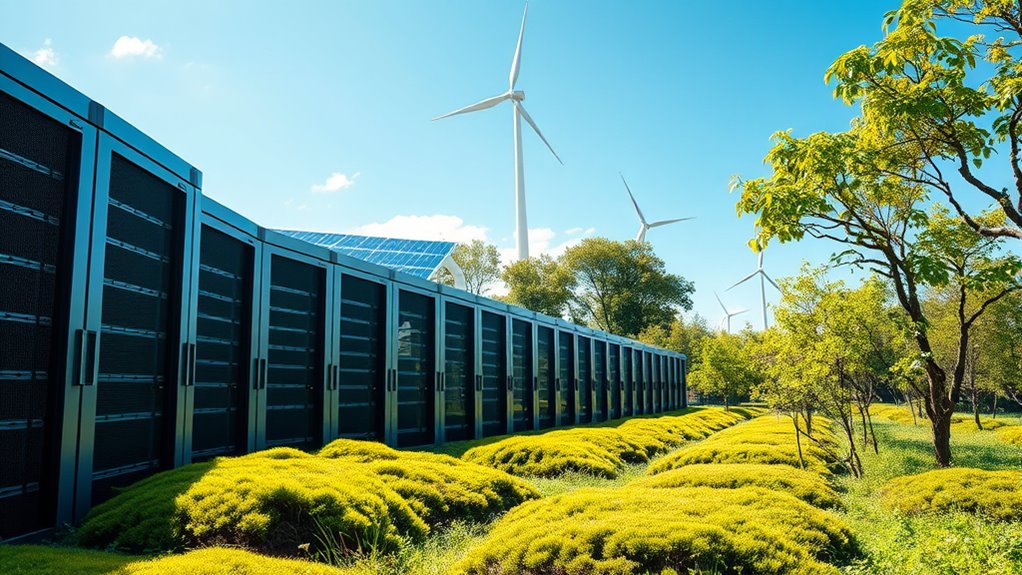
Advances in energy-efficient hardware and automation are transforming sustainable cloud solutions. By designing processors and systems that maximize performance while minimizing energy use, you can reduce environmental impact. Implementing automation and resource optimization further enhances efficiency, helping your cloud infrastructure operate greener and more cost-effectively.
Energy-Efficient Hardware Design
Innovations in hardware design play a essential role in making cloud computing more energy-efficient and sustainable. You’ll see low-power processors that deliver high performance while using less energy, thanks to technologies like dynamic voltage scaling and multi-core architectures. Specialized hardware accelerators optimize power use by trading off some flexibility for efficiency. ARM-based processors, known for their lower power draw than traditional x86 chips, are increasingly common. Additionally, solid-state drives (SSDs) consume less energy and offer faster data access, boosting overall system efficiency. Imagine:
- Processors that dynamically adjust power based on workload, reducing energy waste.
- Accelerators that perform specific tasks with minimal power consumption.
- SSDs that speed up data transfer while using less energy, keeping your cloud environment greener.
Automation and Resource Optimization
Automation and resource optimization are transforming how cloud environments operate by making them more efficient and sustainable. You can leverage auto-provisioning to automatically deploy the right resources for your applications, reducing waste and improving performance. Rightsizing and autoscaling tools, like Densify, continuously analyze workloads, recommending ideal configurations and scaling resources based on demand. Intelligent workload analysis helps identify underutilized resources, ensuring you don’t pay for unused capacity. AI-powered optimization predicts future needs, minimizing overprovisioning and energy use. Integration with existing DevOps tools streamlines operations, reducing manual effort. By automatically detecting and managing orphaned instances, predictive scaling, and utilizing cost dashboards, you cut costs and environmental impact. These advances make your cloud infrastructure smarter, greener, and more cost-effective.
Regulatory Standards and Corporate Responsibility
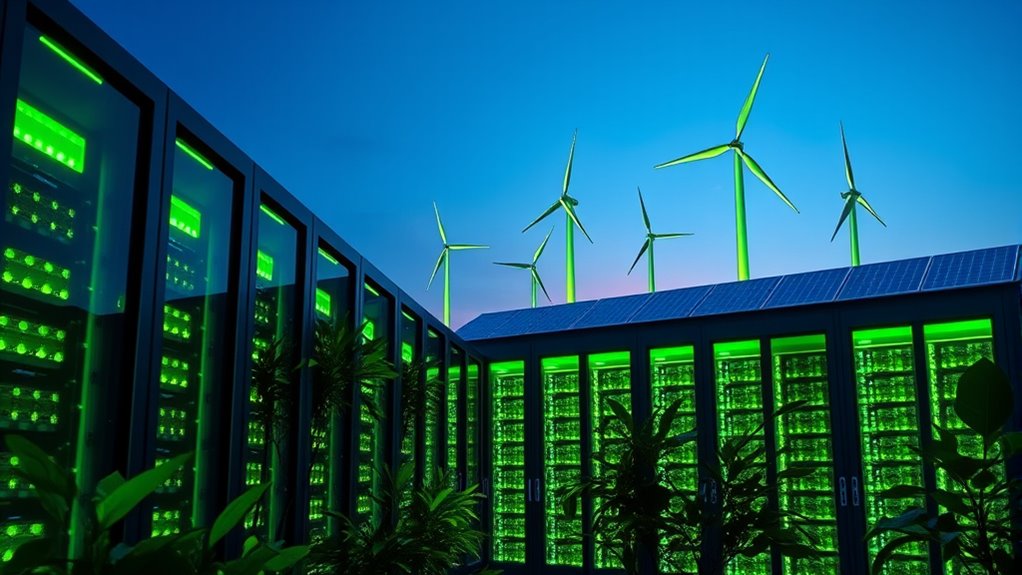
Regulatory standards substantially shape how green cloud hosting operates, compelling providers to meet strict environmental and security requirements. You’ll notice that compliance with frameworks like the EU Energy Efficiency Directive pushes data centers to report energy and water use annually, fostering transparency. The Digital Operational Resilience Act (DORA) forces financial institutions to bolster cyber resilience, impacting data center operations. Additionally, providers must adhere to evolving green regulations, driving innovation in sustainable practices. To visualize this, consider:
- Data centers logging energy use in EU databases, promoting accountability.
- Cloud companies investing in green tech to meet stringent standards.
- Enhanced security protocols ensuring data privacy while supporting sustainability.
These regulations push your cloud provider toward more sustainable, secure, and responsible operations, aligning business practices with global environmental and security expectations.
Future Outlook: Sustainable Development in Cloud Infrastructure
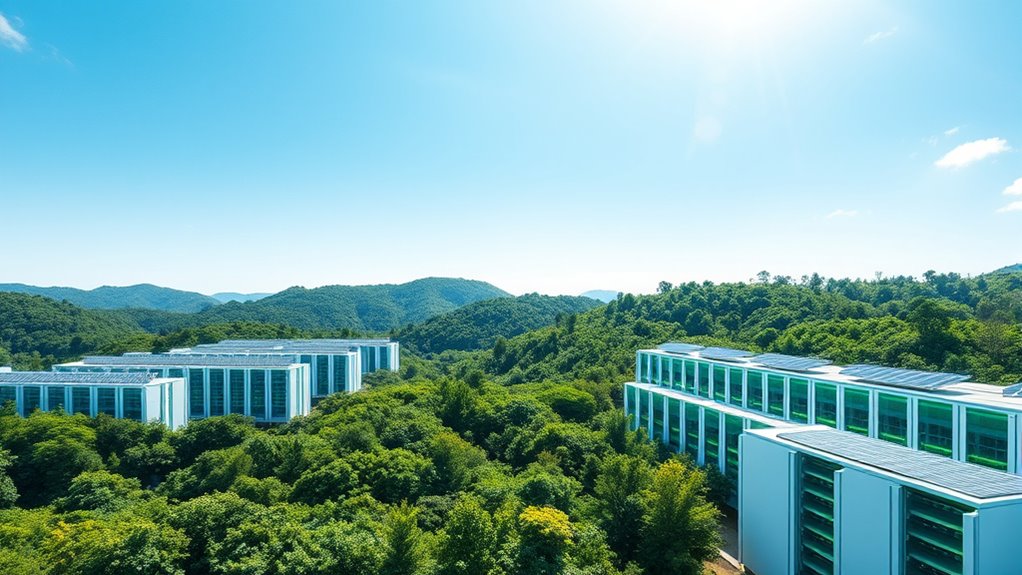
As the push for sustainable development accelerates, cloud infrastructure is increasingly integrating renewable energy sources like solar, wind, and hydro to power data centers, with leading providers aiming for carbon neutrality by the mid-2020s. You’ll see advanced energy storage solutions managing intermittency, ensuring continuous operations. Hyperscale operators like AWS, Microsoft, and Google prioritize renewable energy agreements, which serve as a competitive advantage for customers choosing eco-friendly providers. Additionally, efficiency improvements through innovative cooling and power management reduce water and energy consumption. The rise of green cloud architectures and superclouds streamlines workload scaling and resource utilization, further supporting sustainability. These developments will shape a future where cloud infrastructure not only meets demand but does so responsibly.
| Initiative | Key Technologies | Impact |
|---|---|---|
| Renewable Energy Integration | Solar, wind, hydro | Lower carbon footprint |
| Cooling & Power Efficiency | Liquid cooling, AI management | Reduced resource usage |
| Cloud Architecture | Superclouds, green design | Enhanced eco-efficiency |
Frequently Asked Questions
How Do Renewable Energy Sources Impact Cloud Service Reliability?
Renewable energy sources can both challenge and enhance your cloud service reliability. Their variable output requires backup systems like batteries and smart grid management to guarantee steady power. By integrating energy storage and advanced forecasting, you can sustain consistent operations despite fluctuations. This combination helps you reduce carbon footprints, lower costs, and create a resilient, sustainable infrastructure that supports your cloud services reliably even as renewable adoption grows.
What Are the Costs Associated With Green Hosting Certifications?
Are certification costs worth the investment? You’ll find that green hosting certifications, like Green Key or LEED, involve initial expenses such as application fees and audits, which vary by country and standard. While these costs might seem high upfront, they pay off through enhanced reputation, customer trust, and long-term savings on energy. Plus, staying ahead of regulations can prevent future penalties, making certification a smart, sustainable choice.
How Do Cooling Innovations Reduce Overall Data Center Energy Use?
Cooling innovations reduce your data center’s energy use by improving efficiency and cutting waste. Liquid cooling systems transfer heat more effectively, lowering energy demand by up to 90%, while airflow containment minimizes mixing, preventing overcooling. Implementing fault detection and predictive maintenance keeps systems running smoothly, avoiding unnecessary energy waste. Water-efficient cooling methods also reduce water consumption, ensuring your data center uses less power and resources, ultimately lowering operational costs and environmental impact.
What Challenges Exist in Achieving 100% Renewable Energy Targets?
You face significant challenges in reaching 100% renewable energy targets. High energy demands and grid limitations make it tough to rely solely on renewables. You also encounter technical hurdles like managing fluctuating renewable outputs and ensuring reliable power. Supply chain emissions and long infrastructure lead times add complexity. Plus, workforce shortages and high costs slow down deployment, making it harder to fully shift to renewable sources quickly and efficiently.
How Can Small Businesses Adopt Sustainable Cloud Hosting Practices?
You can turn your small business into a green beacon by choosing cloud providers powered by renewable energy, like wind or solar. Use auto-scaling and right-sizing to cut waste, and schedule tasks during off-peak hours to ease energy demand. Encourage eco-friendly habits among employees, such as turning off devices when not in use. Regularly monitor your energy footprint with tools that measure emissions, making your sustainability journey clear and impactful.
Conclusion
As you embrace the green cloud revolution, remember that sustainability isn’t just a passing fad—it’s the future. Just like the Renaissance transformed art and thought, today’s innovations in renewable energy and eco-friendly practices are reshaping the industry. By choosing green hosting, you become part of a movement that’s reducing emissions and protecting our planet, proving that even in a digital age, we can channel the wisdom of old to build a brighter, greener tomorrow.


